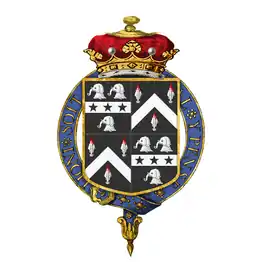John Pratt, 1st Marquess Camden
John Jeffreys Pratt, 1st Marquess Camden, KG, PC (11 February 1759 – 8 October 1840), styled Viscount Bayham from 1786 to 1794 and known as The Earl Camden from 1794 to 1812, was a British politician. He served as Lord Lieutenant of Ireland between 1795 and 1798 and as Secretary of State for War and the Colonies between 1804 and 1805.

Background and education
John Jeffreys Pratt was born at Lincoln's Inn Fields, London, the only son of the barrister Charles Pratt, KC (a son of Sir John Pratt, a former Lord Chief Justice of the King's Bench), and Elizabeth, daughter of Nicholas Jeffreys, of The Priory, Brecknockshire.[1] He was baptised on the day Halley's Comet appeared. In 1765, his father (by then Sir Charles Pratt, having been appointed Chief Justice of the Common Pleas in 1762) was created Baron Camden, at which point he became The Hon. John Pratt. He was educated at the University of Cambridge (Trinity College).[1][2]
Political career
In 1780, Pratt was elected Member of Parliament for Bath[1][3] and obtained the position of Teller of the Exchequer the same year,[1] a lucrative office which he kept until his death, although after 1812 he refused to receive the large income arising from it. He served under Lord Shelburne as Lord of the Admiralty between 1782 and 1783 and in the same post under William Pitt the Younger between 1783 and 1789, as well as a Lord of the Treasury between 1789 and 1792.[1]
In 1786, his father was created Earl Camden, at which point he became known by one of his father's subsidiary titles as Viscount Bayham.
In 1793, Bayham was sworn of the Privy Council. In 1794 he succeeded his father as 2nd Earl Camden, and the following year he was appointed Lord Lieutenant of Ireland by Pitt.[4]
Disliked in Ireland as an opponent of Roman Catholic emancipation and as the exponent of an unpopular policy, Camden's term of office was one of turbulence, culminating in the rebellion of 1798; his refusal to reprieve the United Irishman William Orr, convicted of treason on the word of one witness of dubious credit, aroused great public indignation.[5]
Immediately after the suppression of the rising Camden resigned.[1] In 1804 he became Secretary of State for War and the Colonies under Pitt,[6] and in 1805 Lord President of the Council,[7] an office he retained until 1806. He was again Lord President from 1807 to 1812,[1] after which date he remained for some time in the cabinet without office. In 1812 he was created Earl of Brecknock and Marquess Camden.[8]
The enforced resignation from the Cabinet of Lord Castlereagh, the stepson of his sister Frances, to whom he had always been personally close, in September 1809, led to a series of bitter family quarrels, when it became clear that Camden had known for months of the plan to dismiss Castlereagh, but had given him no warning. Castlereagh himself regarded Camden as "a weak friend", not an enemy, and they were eventually reconciled. Other members of the Stewart family, however, never forgave Camden for what they regarded as his disloyalty.
Camden was also Lord Lieutenant of Kent between 1808 and 1840[1][9] and Chancellor of Cambridge University between 1834 and 1840.[1] He was made a Knight of the Garter in 1799[10] and elected a Fellow of the Society of Antiquaries of London in 1802.[1]
Family
Lord Camden married Frances, daughter of William Molesworth, in 1785. She died at Bayham Abbey, Sussex, in July 1829. Lord Camden survived her by eleven years and died at Seale, Surrey, on 8 October 1840, aged 81. He was succeeded by his only son, George.[1]
The family owned and lived in a house located at 22 Arlington Street in St. James's, a district of the City of Westminster in central London,[11] which is adjoining the Ritz Hotel.[12] In the year of his death, he sold the house to Major Henry Somerset, 7th Duke of Beaufort.[11]
References
- thepeerage.com Sir John Jeffreys Pratt, 1st Marquess Camden
- "Hon. John Jeffreys Pratt (PRT776JJ)". A Cambridge Alumni Database. University of Cambridge. Retrieved 30 March 2016.
- "leighrayment.com House of Commons: Baillieston to Beckenham". Archived from the original on 17 November 2013. Retrieved 1 November 2009.
- "No. 13759". The London Gazette. 10 March 1795. p. 229.
- Ball, F. Elrington The Judges in Ireland 1221-1921 John Murray London 1926 Vol.2 p.183
- "No. 15704". The London Gazette. 22 May 1804. p. 649.
- "No. 15823". The London Gazette. 9 July 1805. p. 897.
- "No. 16632". The London Gazette. 11 August 1812. p. 1579.
- leighrayment.com Peerage: Cable to Cardwell
- "No. 15169". The London Gazette. 13 August 1799. p. 814.
- Chancellor, E. Beresford (1908). The Private Palaces of London Past and Present. London: Kegan Paul, Trench, Trübner & Co Ltd. pp. 366–367. Retrieved 30 June 2015.
- "About this project". Architecture. London, England: The Royal Institute of British Architects. Retrieved 30 June 2015.
External links
- Hansard 1803–2005: contributions in Parliament by the Marquess Camden
- . Encyclopædia Britannica (11th ed.). 1911.
%252C_Marquis_Camden_by_William_Salter.jpg.webp)